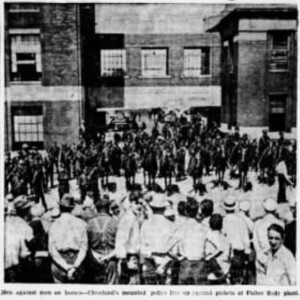
On this day in labor history, the year was 1939.
That was the day striking autoworkers in Cleveland, Ohio defended their picket lines in what is known as “The Battle of East 140th Street.”
Members of UAW Local 45 at GM’s Fisher Body plant had been on strike for three weeks.
They had joined striking GM workers at 12 plants throughout Michigan.
They demanded a supplemental agreement granting skilled workers wage increases, overtime adjustments and seniority, and apprentice provisions.
In Cleveland, strikers vowed to stop the scabbing and were mostly successful.
Now, at the start of the morning shift, a scab attempted to plow through picket lines at high speed.
Strikers flooded the gates and brought the scab car to a virtual stop.
As they attempted to convince him not to cross through, mounted police viciously charged and attacked the strikers.
Police continued to shoot tear gas guns from behind plant gates.
Soon, there were more than 5000 picketers fighting with police, as workers poured out from half a dozen nearby plants to support the strikers.
For over two hours, workers showered strikebreaking forces with bricks, rocks and paving blocks.
They overturned scab cars and drove the police off the streets and into the plant.
Fighting broke out again in the afternoon when police tried to bring in more tear gas supplies.
Strike leaders directed activities from an amplifier on the roof of a nearby restaurant.
The next day, famed prohibition crusader, Eliot Ness, now Cleveland’s Director of Public Safety, enforced a 500 yard ”riot zone,” banning all gatherings near the gates and limited picketers to seven at each gate.
Strikers began picketing the homes of known scabs and would ratify a new contract just days later.
More Episodes
 2024-11-12
2024-11-12
 2024-11-10
2024-11-10
 2024-11-09
2024-11-09
 2024-11-08
2024-11-08
 2024-11-06
2024-11-06
 2024-11-05
2024-11-05
 2024-11-04
2024-11-04
 2024-11-03
2024-11-03
 2024-11-02
2024-11-02
 2024-11-01
2024-11-01
 2024-11-01
2024-11-01
 2024-11-01
2024-11-01
 2024-11-01
2024-11-01
 2024-11-01
2024-11-01
 2024-11-01
2024-11-01
Create your
podcast in
minutes
- Full-featured podcast site
- Unlimited storage and bandwidth
- Comprehensive podcast stats
- Distribute to Apple Podcasts, Spotify, and more
- Make money with your podcast
It is Free
- Privacy Policy
- Cookie Policy
- Terms of Use
- Consent Preferences
- Copyright © 2015-2024 Podbean.com




